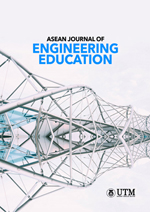Mathematical Competence of Practicing Engineers in Engineering Tasks
DOI:
https://doi.org/10.11113/ajee2023.7n2.132Keywords:
Mathematics at workplace, mathematics in industry, phenomenological method, mathematical competencyAbstract
Due to the complexity of the problems that engineers must solve; they must receive training in real-life problem-solving scenarios. The Engineering Accreditation Council (EAC) and Board of Engineering of Malaysia (BEM) place a significant emphasis on engineering competencies in Program Learning Outcome (PLO), including the ability to apply mathematical knowledge to engineering problems. However, students at universities face challenges in understanding engineering mathematics, as they are not typically taught by specialized instructors. Therefore, a phenomenological approach was utilized in this study to identify the mathematical competencies (MC) among practicing engineers in manufacturing workplaces. Three engineers were selected as potential respondents, but only one participated in the study. Data was collected through intensive interviews conducted in the workplace. The phenomenological reduction technique was employed, utilizing Epoche, Identification of significant statements, Meaning Units, Textural Description of the Experience, Structural Descriptions of the Experience, and Textural-Structural Synthesis phenomenology for data analysis. This method offers a logical, systematic, and coherent design that produces an essential description of the experience. The study's findings indicate that mathematical competencies frequently used by engineers include mathematical thinking, problem-solving skills, and mathematical communication. This study could inform instructors about developing mathematical competencies relevant to real-life problem-solving in engineering activities and academic programs at their institutions.



















